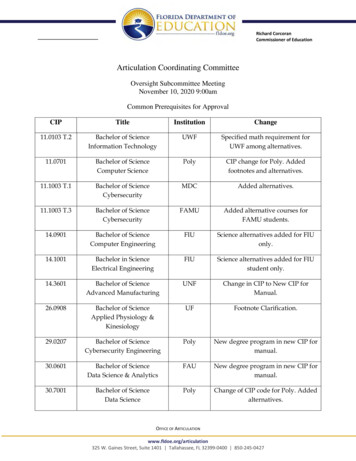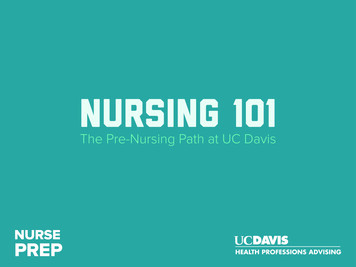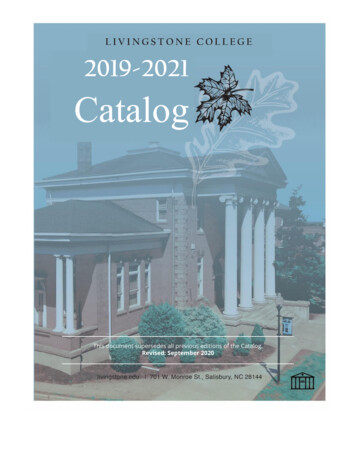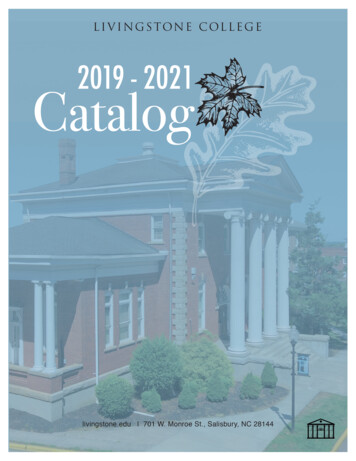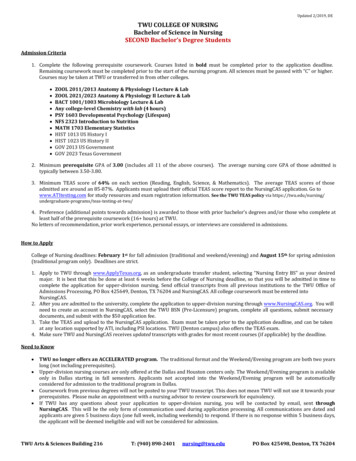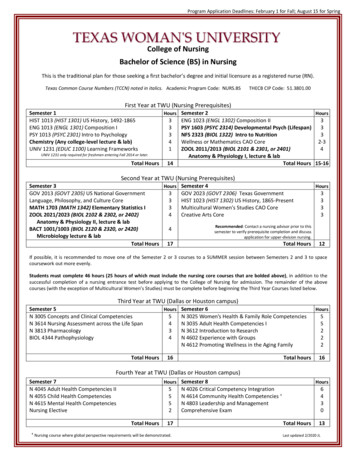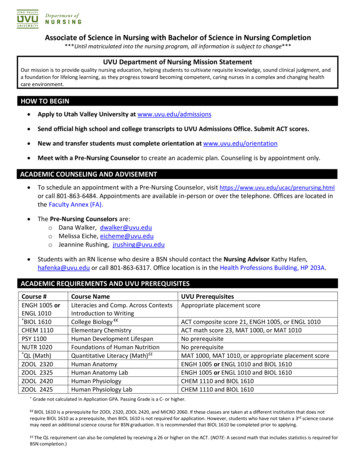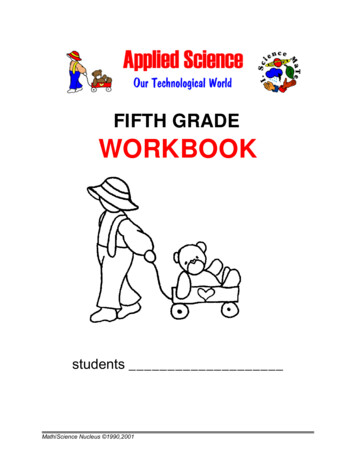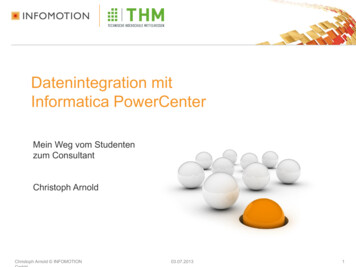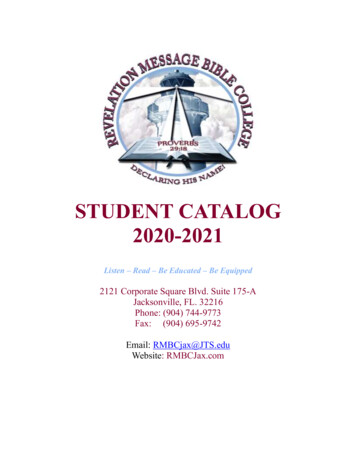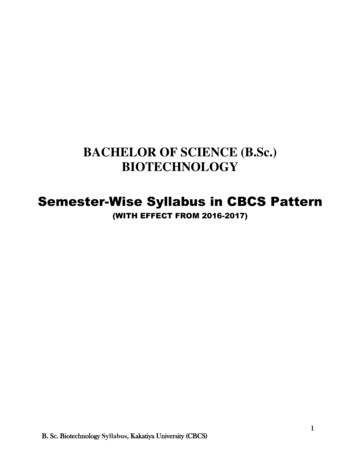
Transcription
BACHELOR OF SCIENCE (B.Sc.)BIOTECHNOLOGYSemester-Wise Syllabus in CBCS Pattern(WITH EFFECT FROM 2016-2017)1B. Sc. Biotechnology Syllabus, Kakatiya University (CBCS)
Scheme For Choice Based Credit SystemMax. MarksCodeSemesterCoursecategoryTitle of the PaperNo. T eory)BS204IIDSC-1B(Practical)Cell Biology & GeneticsNucleic Acids- Biostatistics 25SECOND YEARDSC-1C(Theory)BS304Biological DSC-1D(Practical)Microbiology 12-252533156075THRID YEARDSC-1E(Theory)BS503DSC-1E(Practical)Molecular Biology & cal)Elective Paper A/BDSC-1F(Theory)10012-252533156075Microbial F(Theory)33156075VIBS606Elective Paper A/BDSC-1F(Practical)Summary of Credits10012-252536----9002B. Sc. Biotechnology Syllabus, Kakatiya University (CBCS)
B.Sc- I Year, Semester – IPAPER - ICELL BIOLOGY & GENETICSUNIT- I1.11.21.31.41.5: Cell Structure and FunctionDiscovery of Cell and Cell theory.Cell as basic unit of life (Viral, bacterial, fungal, plant and animal cells)Ultra structure of prokaryotic cell ( Extra Chromosomal Material – Plasmid)Ultra structure of eukaryotic cell (Cell wall, cell membrane, Golgi Complexes,Endoplasmic Reticulum, Peroxisome, Lysosomes etc).Semi- autonomous Organelles (Mitochondria & Chloroplast : Endosymbiotic theroy)UNIT-II : Chromosome Organization and Cell Division2.12.22.32.42.5Chromosome organization in Prokaryotes and EukaryotesStructure of specialized chromosomes (Polytene and Lamp Brush)Cell Division , Cell Cycle controlSignificance of Mitosis and MeiosisProgrammed Cell DeathUNIT- III : Mendalism & Mendel’s Laws3.1 Mendel’s experiments – Factors contributing to success of Mendel’s experiments3.2 Mendel,s laws - Law of segregation – Monohybrid ratio, Law of Independent assortment– Dihybrids, Trihybrids3.3 Deviation from Mendel’s Laws - partial or incomplete dominance, co-dominance3.4 Penetrance and expressivity, Pleiotropism3.5 Gene interaction – Modified dihybrid ratios (12:3:1; 9:7; !5:1; 9:3:4:, 9:6:1; 13:3), MultipleAlleles : ABO blood groups & Rh factorUNIT-IV : Sex Determination & Recombination4.1 Genes and environment – phenocopies4.2 Linkage and recombination – Discovery of linkage, cytological proof of crossingover, Recombination frequency and map distance. Interference and coincidenceMitotic crossing over in Drosophila4.3 Mechanism of sex determination-genic balance theory - DrosophilaHomogametic and Heterogametic theory (Human, Mamalian, Birds)4.4 X – linked inheritance (eg. Haemophilia)4.5 Non-Mendelian inheritance - Cytoplasmic inheritance (Shell coiling in snail)3B. Sc. Biotechnology Syllabus, Kakatiya University (CBCS)
Recommended Books:1. Cell Biology and Genetics- By P.K. Gupta2. Karp, G. 2010. Cell and Molecular Biology: Concepts and Experiments. 6th Edition.John Wiley & Sons. Inc.3. De Robertis, E.D.P. and De Robertis, E.M.F. 2006. Cell and Molecular Biology. 8thedition.Lippincott Williams and Wilkins, Philadelphia.4. Cooper, G.M. and Hausman, R.E. 2009. The Cell: A Molecular Approach. 5th edition.ASMPress & Sunderland, Washington, D.C.; Sinauer Associates, MA.5. Becker, W.M., Kleinsmith, L.J., Hardin. J. and Bertoni, G. P. 2009. The World of theCell. 7th edition. Pearson Benjamin Cummings Publishing, San Francisco.6. Cell Biology, DE Robertis & De Roberis, Blaze publishers & Distributors Pvt. Ltd.,6. Cell and Molecular Biology- By De Robertis7. Cell and Molecular Biology- By Lodish8. Theory and Problems in Genetics - By Stransfield9. Genetics- By Gardner (Macmillan Press)Practical Paper – I1.2.3.4.5.6.Monohybrid and dihybrid ratio in Drosophila/maizePreparation of different stages of Mitosis and MeiosisIdentification of plant, fungi, bacteria and animal cells.Epistasis and codominance, 2 point test cross, gene mapping.Prepation of polytenen chromosomes from Drosophila salivary gland.Identificaiton, maintenanace and culturing of Drosophila stock.Spotters:1. Prokaryotic cell (Bacteria)2. Mitochondria3. Chloroplast4. Histone proteins5. Polytene6. Lampbrush7. Test cross8. Blood grouping9. Webbed foot10. Haemophilia11. Crossing over12. Phenocopies4B. Sc. Biotechnology Syllabus, Kakatiya University (CBCS)
B.Sc- I Year, Semester – IIPAPER-IINUCLEIC ACIDS- BIOSTATISTICS – BIOINFORMATICSUNIT- I : Structure of Nucleic Acids1.11.21.31.41.5DNA as the genetic material – Griffiths experiments, Avery, Mc Leod and Mc Carty’sexperiments. Hershey – Chase experiments.RNA as genetic material – Tobacco Mosaic VirusStructure and chemistry of DNA – Watson and Crick ModelForms of DNA – A, B and Z forms of DNA, Super coiled and relaxed DNA – Role of DNAtopoisomerases.Structure of Cytoplasmic DNA – chloroplast DNA and Mitochondrial DNA.UNIT- II : Functions & Mechanisms of Nucleic Acids2.1 DNA Replication – Models of DNA replication (Semi-conservative, non-conservative models)2.2 Mechanisms of DNA replication – Linear and circular – Rolling circle and theta mechanism ofreplication. Enzymes involved in DNA replication.2.3 Mutation- spontaneous, induced- Physical and chemical (frame shift, transition,transversion)2.4 DNA damage and Repair mechanisms2.5 DNA RecombinationUNIT- III : Concepts of Biostatistics3.1 Concept of probability, basic laws and its application to Mendelian segregation. Concept ofProbability Distribution. Binomial and Poisson Distributions, Normal Distribution and theirapplication in Biology3.2 Concept of Sampling and Sampling Distribution. Measures of Central tendency (Mean, Median,Mode), Measures of deviation (Strandard deviation, variance and coefficient of variation).3.3 Concept of Test of Hypothesis. Applications of t-test statistics to biological problems/data: Chisquare, statistic applications in Biology3.4 Simple Regression and Correlation.3.5 Concept of analysis of variance (one-way classification)UNIT- IVConcepts of Computers & Bioinformatics4.1 Usage of MS DOS commands: Basic concept of Internal & External commands, directory &file commands, copying, erasing, renaming, and displaying files.4.2 Microsoft word: Concept of toolbar, character, paragraph & document formatting, drawingtool bar, header, footer, document editing, page setup, short cut keys, text & graphics.4.3 Microsoft power point: Slide presentation, slide layout & design, custom animation, imageimporting, slide transition.5B. Sc. Biotechnology Syllabus, Kakatiya University (CBCS)
4.4 Bioinformatics - Databases – (Nucleic acid and protein), Introduction to genomics andproteomics.4.5. Data retrieval toos – (BLAST, PubMED)Practical Paper - II1.2.3.4.5.6.Estimation of DNA by diphenylamine methodEstimation of RNA by orcinol methodFinding statistical significance of a given data using chi – square test.Graphical representation of data (Histograms, frequency polygen, Pie diagram)Acquaintance with the Biological databases through InternetMicro soft Power point presentation.Spotters :1. TMV2. B-DNA3. Z-DNA4. Replication fork5. Okazakifragment6. SOS repair7. Probability theorems8. Test of hypothesis9. F-test10. Biological databases11. NCBI12. BLASTRecommended Books1.2.3.4.5.6.7.8.9.10.11.12.Molecular Biology FreifelderCell & Moelcular Biology – Schwann SeriesCell and Molecular Biology - By De RobertisCell and Molecular Biology - By LodishBasics in Computers –MS officeBiometry- By Sokal and Rohlf W.H. FreemanFundamentals of Biometry - By L.N. Balaram (George Allen and Unwin Ltd, LondonBiostatistics- By N.T.J. BaileyBiostatistics- Manual of biostatistical methods for use in health, nutrition andAnthropology- By K. Visweshwar Rao (Jaypee Publications).Bioinformatics and Bioprogramming in C - By L.N. ChavaliIntroduction to Bioinformatics- By V. KothekarIntroduction to Bioinformatics- By Arthur M. Lesk6B. Sc. Biotechnology Syllabus, Kakatiya University (CBCS)
B.Sc -II Year–Semester - IIIPAPER-IIIBIOLOGICAL CHEMISTRYUNIT- I Carbohydrates1.1. Carbohydrates-Importance, classification and physical and chemicalproperties ofcarbohydrates1.2. Structure, configuration and biochemical importance of Monosaccharides (Glucose andFructose)Oxidation, Reduction, Osazone formation, Aldose & Ketose, Glycosides(Streptomycin, Cardiac glycosides and Ouabain)1.3. Structure, configuration and biochemical importance of Disachharides and glycosidic bond ,Mutarotation, Haworth projection(Sucrose, Trehalose, Lactose, Maltose, Isomaltose,Cellobiose)1.4. Homopolysaccharides (Starch, Glycogen, inulin, Cellulose and Chitin)1.5. Hetero polysachharides (Hyaluroic acid, Chondroitin sulfate, heparin, peptidoglycan)UNIT – II Proteins and Enzymes2.1 Classification, structure and physical and chemical properties of aminoacids and synthesis ofPeptide bond2.2 Lipids,Fattyacids-importance, properties and classification, Simple lipids-TAG, Complexlipids, Derived lipids, sterols, Fatty acids: Saturated and Unsaturated fatty acids with examples.Biosynthesis of Fatty acids -palmitoyl-CoA, Cholesterol2.3 Enzymes-classification and nomenclature. Michaelis Menton Equation-Factors influencing theenzyme reactions and Enzyme inhibition(Competitive and Non-competitive), role of coenzymes and Enzyme Techonology.2.4 Hormones, mode of action, (Thyroid gland)2.5 Vitamins- classification, sources, functions and applicationsUNIT – III Bioenergistics of is and its significanceTCA Cycle, electron transport, Oxidative phosphorylationβ-oxidation of fatty acidTransamination and Oxidative deamination reactions of amino acids. Amino acidcatabolism (Phenyl ketonuria, albinism)UNIT – 1V Bioanalytical techniques4.1. Microscopy – light, inverted, fluorescent and electron microscopy4.2. Colorimetry: Beer and Lambert’s laws and UV- Vis spectrophotometry.4.3. Separation techniques – Chromatography( Paper, thin layer, ion exchange and HPLC).4.4 Electrophoresis (Native gels and SDS-PAGE, Agarose)4.5 Basic principles of Centrifugation7B. Sc. Biotechnology Syllabus, Kakatiya University (CBCS)
Practical paper - III1.2.3.4.5.6.Qualitative tests of Sugars, amino acids and lipidsEstimation of proteins by Biurate methodEstimation of total sugars by Anthron methodReducing sugars DNS methodSeparation of protein by SDS – PAGE.Separation of amino acids by paper chromatography, TLCSpotters1. Cellulose2. Peptidoglycan3. Streptomycin4. Cholesterol5. Lock and Key model6. Xerophthalmia7. RUBISCO8. Albinism9. ATP synthase10. Centrifuge11. Microscope12. SpectrophotometerREFERENCE BOOKS1. Lehninger Principles of Biochemistry By: David L. Nelson and Cox2. Biochemistry By: Rex Montgomery3. Harper’s Biochemistry By: Robert K. Myrray4. Enzymes By:Trevor Palmer5. Enzyme structure and mechanism By: AlanFersht6. Principles of Biochemistry By: Donald J. Voet, Judith G.Voet, Charlotte W.Pratt7. Analytical Biochemistry By Cooper8. Principles and techniques of Biochemistry and Molecular Biology Edited By KeithWilson and John Walker9. Experimental Biochemistry: A Student Companion by Sashidhar Beedu et al10. Practical Biochemistry By Plummer8B. Sc. Biotechnology Syllabus, Kakatiya University (CBCS)
B.Sc- II Year, Semester – IVPAPER-IVMICROBIOLOGY AND IMMUNOLGYUNIT – I Fundamentals of Microbiology1.1 Outlines of classification of Microorganisms.1.2.Sterilization techniques (Physical and Chemical).1.3. Structure and general characteristics of Bacteria (Archaeobacteria, Cyano bacteria), Viruses(TMV, HIV),Micro algae (Clostirium,Chlamydomonas) and Fungi (Aspergillus, Pencillium)1.4. Diseases caused by pathogenic fungi, bacteria, and viruses in humans1.5. Isolation, identification and preservation of microorganisms (Bacteria).UNIT – II Bacterial growth and nutrition2.1 Bacterial nutrition , Nutritional types of bacteria, Essential macronutrients, micronutrients andgrowth factors.2.2 Nutrient transport in bacteria -Simple diffusion, facilitated diffusion, passive and active transport.2.3 Bacterial growth, Typical growth curve-batch and continuous cultures, synchronous cultures,Measurement of bacterial growth- measurement of cell number and cell mass2.4 Factors effecting bacterial growth-Temperature, pH, water activity, oxygen concentration, saltconcentration, pressure and radiation.2.5 Measurement of cell mass by dry weight and metabolic activity.UNIT – III Immunology – I3.1.Introduction to immune system- organs and cells of immune system3.2. Types of Immunity (Innate and Acquired)3.3. Antigens, haptens physical chemical characteristics.3.4. Structure of different immune globulins and their functions- primary and secondary antibodyresponses.3.5.Antigen antibody interactions and antibody diversity. Types of MHC and role in organtransplantation.UNIT – IV Immunology – II4.1. Structure and functions of cytokines4.2. T-cell maturation, activation and differentiation4.3. B-cell activation, differentiation and proliferation.4.4. Monoclonal antibodies, production and applications4.5. Hypersensitivity- Coombs classification, types of hypersensitivity and Autoimmunediseases- mechanism of auto immunity.9B. Sc. Biotechnology Syllabus, Kakatiya University (CBCS)
Practical paper - IV1. Preparation of microbiological media2. Isolation of bacteria by streak, spread, and pour plate method3. Staining and identification of bacteria-( Gram staining and simple straining)4. ELISA test5. Microagglutination using microtiter plates (eg. ABO and Rh Blood grouping)6. RBC /WBC countSpotters1. HIV2. Autoclave3. Laminar Air Flow4. Bacterial growth curve5. Cyanobacteria6. Hot air oven7. Immunoglobulin8. Monoclonal antibody9. Vaccine10. Haptens11. Macrophage12. Haemoglobin,, REFERENCE BOOKS1.2.3.4.5.6.7.8.9.10.11.12.Brock, T.D. and Madigan, M.T. Biology of MicroorganismsPrescott, L.M., Harley, J.P. Klein, D.A. MicrobiologyPelczar, M.J, Chan, E.C.S., Ereig, N.R. MicrobiologyBenson Microbiological applicationsFreifelder, D Physical biochemistry: application to biochemistry and molecular biologyWilson & Walker Practical biochemistryUpadhyaya and Upadhyaya Physical biochemistryEssential Immunology - By I. Roitt, Publ: BlackwellMicrobial Genetics - By S.R. Maloy, J.E. Cronan & D. Freifelder, Publ: Jones & BarlettImmunology - By G. Reever & I. Todd, Publ: BlackwellFrom Genes to Clones - By E.L. Winnacker, Publ: Panima, New DelhiImmuno diagnostics - By S.C. Rastogi, Publ: New Age10B. Sc. Biotechnology Syllabus, Kakatiya University (CBCS)
B.Sc- III Year, Semester – VPAPER-VMolecular biology and r-DNA technologyUNIT – I Gene expression1.1 . Transcription in prokaryotes: Enzymatic Synthesis of RNA, Basic features of RNAsynthesis, E.coli RNA polymerase, Classes of RNA molecules, Transcriptionmechanism in prokaryotes- Promoter, initiation, elongation, proof reading and Rhodependent and Rho independent termination.1.2 . Transcription in Eukaryotes: Polymerases of eukaryotes, Promoters of eukaryotes,1.3 . Synthesis of hn RNA, Splicing mechanisms-Self splicing, protein mediated splicing,alternative splicing, Capping and polyadenylation.1.4 . The Genetic Code, properties of genetic code, Wobble hypothesis.1.5 . Translation mechanism in prokaryotes and eukaryotesUNIT – II Regulation of Gene expression2.1. Regulation in Prokaryotes: General aspects of Regulation2.2. Transcription level regulation-positive, negative, auto and coordinated regulation2.3. Operon concept – lac, trp, operons.2.4. Transcriptional Control through Transcription factors.2.5 .Translation regulation in Eukaryotic and prokaryotic organismUNIT – III r-DNA technology3.1. Enzymes used in gene cloning: restriction endonucleases, ligases, phosphatases,methylases, kinases.3.2. Cloning vehicles, plasmids, cosmids, phage vectors, Shuttle vectors Baculovirus vectorsystem, expression vectors, expression cassettes.3.3. Construction of genomic and cDNA libraries. Identification of cloned genes3.4. Principles involved in blotting techniques- southern, northern and western.3.5. Principles and application of PCR Technology and DNA fingerprinting technique andits application.11B. Sc. Biotechnology Syllabus, Kakatiya University (CBCS)
Practical Paper – V1.2.3.4.5.6.Isolation of DNA from plant, animal/bacterial cellsIsolation of plasmid DNAAnalysis of DNA by agarose gel electrophoresisRestriction digestion of DNAPCRCompetent cell preparation, transformation and Pt – RNALac Operon5 – capPBR 322Reverse transcriptaseShine – Dalgarno sequenceTaq DNA polymeraseREFERENCE BOOKS1. Molecular Biology of the Gene - By Watson, Hopkins, Goberts, Steitz and Weiner (PearsonEducation)2. Cell and Molecular Biology - By Robertis & Robertis, Publ: Waverly3. Text Book of Biotechnology - By H.K. Das (Wiley Publications)4. Gene Structure & Expression - By J.D. Howkins, Publ: Cambridge5. Genetic Engineering - By R. Williamson, Publ: Academic Press6. Principles of Gene Manipulation - By R.W. Old & S.B. Primrose, Publ: Blackwell7. Genes - By B. Lewin - Oxford Univ. Press8. Molecular Biology & Biotechnol. - By H.D. Kumar, Publ: Vikas9. Methods for General & Molecular Bacteriology - By P. Gerhardf et al., Publ: ASM10. Molecular Biotechnology - By G.R. Click and J.J. Pasternak, Publ: Panima11. Genes and Genomes – By Maxine Singer and Paul Berg12. Principles of Gene Manipulation - By R.W. Old & S.B. Primrose, Publ: Blackwell13. Genes - By B. Lewin - Oxford Univ. Press14. Molecular Biology & Biotechnol. - By H.D. Kumar, Publ: Vikas15. Molecular Biology - By D. Freifelder, Publ: Narosa12B. Sc. Biotechnology Syllabus, Kakatiya University (CBCS)
B.Sc- IIIYear, Semester – VELECTIVE PAPER-(A)PLANT BIOTECHNOLOGYUNIT – I Introduction1.1. Historical perspectives of plant tissue culture, and Basic requirement for tissue culture laboratory1.2 . Culture mediums for plant tissue culture- MS medium and B5 Medium. Sterilization ofmedia-steam, dry and filter sterilization- Explants sterilization1.3. Plant growth regulators and differentiation.1.4. Method of tissue culture-formulation of medium explants collection, surface sterilization,inoculation, Callus induction, subculture and regeneration of plants1,5. Suspension cultures- growth and subculture, types and synchronization of suspensioncultures.UNIT - II. Applications of plant tissue culture2.1. Meristem culture and its uses in production of virus free plants2.2. Clonal propagation, Micro propagation of plants – medicinal plants and endangered plants –methodand advantages2.3. Somatic embryogenesis- Principle, protocol and importance. Artificial seeds – production,applications and limitations.2.4. Anther culture and production of androgenic haploids.2.5. Somaclonal variations; - sources of somaclonal variatins, selection of soma clones, progeny testing ofsoma clones, applications of somaclonal variations to crop improvement, Embryo rescueUNIT - III : Applications of plant tissue culture3.1. Protoplast – properties of protoplast ,Protoplast – Isolation (mechanical and enzymatic methods ),Culturing and regeneration of protoplasts , Different methods of protoplast fusion (mechanical fusion,chemo fusion, electro fusion) and Selection of somatic hybrids and cybrids.3.2. Cryopreservation of plant cultures and application of plant tissue culture .3.3. Immobilization of cells and the effect of elicitors on the production of secondary metabolites ofcommercial value3.4. Introduction to Agrobacterium tumifaciens, Features of Ti Plasmid, molecular mechanismof T-DNA transfer.3.5. Physical gene transfer methods – Particle Bombardment, Electrophoration andMicroinjection.13B. Sc. Biotechnology Syllabus, Kakatiya University (CBCS)
Practical paper VII1.2.3.4.5.6.Preparation of medium for tissue culture. (MS or B5)Sterilization methods of explants (seed leaf, inter node &root), mediumEstablishment of callus cultures –from carrot.Cell suspension cultures.Protoplast isolation and culture.Synthetic seed production.Spotters1.2.3.4.5.6.7.8.9.CallusSomatic embryosRhizogenesisMultiple shootsGreen houseSomatic hybridsSynthetic seedsGUS geneGene gunREFERENCE BOOKS1. Plant Tissue Culture and its Biotechnological Applications By W. Barz, E. Reinhard, M.H.Zenk2. Plant Tissue Culture By Akio Fujiwara3. Frontiers of Plant Tissue Culture By Trevor A. Thorpe4. In vitro Haploid Production in Higher Plants by S. Mohan Jain, S.K. Sopory, R.E. Veilleux5. Plant Tissue Culture : Theory and Practice By S.S. Bhojwani and A. Razdan6. Plant Cell, Tissue and Organ Culture, Applied and Fundamental Aspects By Y.P.S. Bajaj andA. Reinhard14B. Sc. Biotechnology Syllabus, Kakatiya University (CBCS)
SEMESTER VELECTIVE THEORY (B)MEDICAL BIOTECHNOLOGYUnit 1: Methods for diagnosis of human diseases1.1 Karyotyping of human chromosomes1.2 Chromosome banding– G banding and R-banding technique1.3 Inheritance patterns in Man– Pedigree analysis1.4 Diagnosis using monoclonal antibodies- ELISA1.5 DNA/RNA based diagnosis– HBV, HIVUnit 2: Inherited disorders2.1 Chromosomal disorders caused due to structural chromosomal abnormalities (Deletions,duplications, Translocations)2.2 Chromosomal disorders caused due to numerical chromosomal abnormalities (autosomaland allosomal)2.3 Monogenic disorders (autosomal and X-linked diseases)2.4 Mitochondrial diseases – LHON, MERRF2.5 Cancer – types, molecular basis of colon cancer and breast cancerUnit 3: Therapeutic approaches for human diseases3.1 Gene therapy – exvivo and invivo gene therapy; somatic and germline gene therapy;3.2 Strategies of gene therapy: gene augmentation – ADA deficiency; Prodrug therapy/suicide gene – glioma3.3 Stem cells – potency definitions; embryonic and adult stem cells; applications of stemcells – cell based therapies and regenerative medicine3.4 Encapsulation technology and therapeutics-Diabetes3.5 DNA based vaccines, subunit vaccines – Herpes Simplex Virus, Recombinant attenuatedvaccines– Cholera15B. Sc. Biotechnology Syllabus, Kakatiya University (CBCS)
ELECTIVE (B): PRACTICALS1.2.3.4.5.6.Karyotyping of normal and abnormal human chromosome setsHuman pedigree analysisEstimation of C-reactive proteinDot ELISAGenotyping of candidate genes for diseases by RFLPEncapsulation of mammalian cellsSPOTTERS1.2.3.4.5.6.7.8.9.PedigreeMonoclonal antibodiesELISAOncogenesCri du Chat syndromeTrisomyDiabetes MellitusSCIDStemcellsREFERENCE BOOKS1. Medical Biotechnology-Pratibha Nallari, V.Venugopal Rao-Oxford Press2. Introduction to Human Molecular Genetics – J.J Pasternak, John Wiley Publishers3. Human Molecular Genetics –Tom Strachen and A P Read, Bios Scxientific Publishers4. Human Genetics Molecular Evolution, Mc Conkey5. Recombinant DNA Technology, AEH Emery6. Principles and Practice of Medical Genetics, I, II, III Volumes by AEH Edts. Emery7. Molecular Biotechnology, Glick and Pasternak16B. Sc. Biotechnology Syllabus, Kakatiya University (CBCS)
SEMESTER VGENERIC ELECTIVEAGRITECHNOLOGYUnit I GM Crops:1. Crop evolution and human civilization; Introduction to GM Crops2. Applications of GM Crops, : (Bt- Cotton; and golden rice), Global area of biotech crops3.Implications of GM-Crops in Agriculture, Public perception on GM crops and scientificsolutions.4. Bioethical issue on GM crops5. Crop seasons and crop rotation, Sustainable agriculture; pheromones, traps etcUnit II Organic farming and Conservation1. Introduction to organic farming, green manure production, Soil fertility and management2. Role of earthworms in soil structure, and productivity, Cost-benefit analysis of vermicomposting3. Invitro propagation and Conservation of forest and medicinal plants4. Conservation of germ plasm, Indigenous cultivars & wild plants5. Commercial cultivation of medicinal and aromatic plantsREFERENCE BOOKS1. Plant Tissue Culture By Akio Fujiwara2. Frontiers of Plant Tissue Culture By Trevor A. Thorpe3. Plant Cell, Tissue and Organ Culture, Applied and Fundamental Aspects By Y.P.S.Bajaj and A. Reinhard4. Text Book of Biotechnology - By H.K. Das (Wiley Publications)5. Biotechnology -By H.J. Rehm and G. Reed. VIH Publications, Germany6. Biogas Technology - By B.T. Nijaguna7. Biotechnology - By K. Trehan8. Food Microbiology - By M.R. Adams and M.O. Moss9. Introduction to Biotechnology - By P.K. Gupta10. Essentials of Biotechnology for Students - By Satya N. Das17B. Sc. Biotechnology Syllabus, Kakatiya University (CBCS)
B.Sc- III Year, Semester – VIPAPER-VIMICROBIAL TECHNOLOGYUnit 1: Introduction to Microbial technology1.1. Introduction to industrial biotechnology, scope and applications1.2. Principles and exploitation of microorganisms and their products1.3. Isolation and screening of microorganisms for industrial products1.4. Strategies for Strain improvement (mutation, selection, recombination)1.5. Preservation of industrial microorganismsUnit 2: Microbial fermentation2.1 Principles of Fermentation technology2.2 Fermentation concept and Design2.3 Types of Fermentations, Formulation and Design of fermentation Media2.4 Substrates used as Carbon and Nitrogen Inoculum development.2.5 Factors affecting fermentation processUnit 3: Microbial technology products and applications3.1 Microbial production of Organic acids (Lactic acid and citric acid)3.2 Microbial production of Amino acids (Glutamic acid and Aspartic acid)3.3 Fermentation by microbes for food additives: dairy products (Bread and SCP), beverages(Beer and Wine) and antibiotics (Penicillin and Streptomycin,)3.4 Therapeutic drugs: Monoclonal antibodies and insulin,3.5 Biofuel: Alcohol and MethaneCORE-VI: PRACTICALS1. Screening of Microorganisms (primary selection, secondary selection)2. Production of Citric acid3. Screening of amylase producing microorganisms5. Production of wine using common yeast6. Production of hydrogen or biogas using cow/cattle dungSpotters:1.2.3.4.5.6.Fermented foodBioreactorSCPInsulinBiogasAmylase18B. Sc. Biotechnology Syllabus, Kakatiya University (CBCS)
7. MAB8. Penicillin9. Down stream processREFERENCE BOOKS1. Text Book of Biotechnology - By H.K. Das (Wiley Publications)2. Biotechnology -By H.J. Rehm and G. Reed. VIH Publications, Germany3. Biogas Technology - By b.T. Nijaguna4. Biotechnology - By K. Trehan5. Industrial Microbiology - By L.E. Casida6. Food Microbiology - By M.R. Adams and M.O. Moss7. Introduction to Biotechnology - By P.K. Gupta8. Essentials of Biotechnology for Students - By Satya N. Das9. Bioprocess Engineering - By Shuler (Pearson Education)10. Essentials of Biotechnology - By Irfan Ali Khan and AtiyaKhanum (Ukaaz Publications)19B. Sc. Biotechnology Syllabus, Kakatiya University (CBCS)
B.Sc- IIIYear, Semester – VIELECTIVE PAPER-(A)ANIMAL BIOTECHNOLOGYUNIT-I Introduction to Animal Biotechnology1.1. Animal tissue culture, history, requirements for animal cell culture1.2. Substrate, liquids, culture mediums-Natural (Clots, Biological fluids, Tissue extracts), complexnatural and chemically defined media1.3. Explant-culture of explants, Cell culture technique- initiation, preparation and sterilization ofmedia, isolation of explants, disaggregation of explants, culture, subculture1.4. Cell lines, evolution of cell lines, maintenance of cell lines, Large scale culture of cell linesmonolayer, suspension and immobilized cell culture, Development of primary culture and celllines, subculture1.6. Stem cells: Characteristic features, maintenance, culture and Applications of Embryonicand adult stem cells, Animal cloning- Nuclear transfer and embryonic stem cell methodUnit-II Secondary Cultures2.1. Cultured cells and evolution of continuous cell lines (established cell lines)2.2. Commonly used cell lines - their origin and characteristics2.3. Cell line preservation and characterization2.4. High level expression of foreign gene in animal cells-expression vectors, enhancers,regulatory sequences. The need to express foreign genes in animal cells: advantage anddisadvantages.2.5. Molecular pharming: Transgenic animals and their applications, methods used fortransgenesis with reference to transgenic mice ,cattle, sheep, goats, pigs, chicken and fish.Unit-II Application of animal cell culture3.1. Transfection methods of animal cells (Calcium phosphate, DEAE-dextran, Lipofection,Electroporation, Microinjection, Embryonic stem cell transfer)3.2. Selection of recombinant cells with various marker genes (Thymidine Kinase, Dihydrofolatereductase, CAD protein, XGPRT, HAT, Neomycin phosphotransferase )3.3. Production of transgenic animals (Mice, Cattle, Sheep, pigs, Fish and Birds)3.4. Animal cells as a bioreactors for the production of commercially important products3.5. Applications, advantages and disadvantages of animal tissue culture and Ethical issues relatedto transgenic animals.20B. Sc. Biotechnology Syllabus, Kakatiya University (CBCS)
PRACTICALS1. Preparation of media2. Isolation of cells from Chick embryo3. Establishment and maintenance of primary cell cultures4. Subculture of monolayer cells5. Subculture of suspension cells6. Determination of viable cells by trypan blue rypsinizationMonolayerTransgenic MiceLipofectionMicroinjectionCell linesMarker genesBioreactorHATREFERENCE BOOKSStrategies in Transgenic Animal Sciences - By Glemn M.M. and James M. Robl ASMPress 2000.Practical Biotechnology – Methods and Protocols - By S. janarthanan and S. Vincent(Universities Press)Animal Cells as Bioreactors - By Terence Gartoright, Cambridge Univ PressMolecular Biotechnology - By Chinnarayappa (Universities Press)Principles and Practice of Animal Tissue Culture - By Sudha Gangal (Universities Press)Introduction to Veterinary Genetics - By F.W. Nicholas, Oxford University PressBiotechnology – By U. SatyanarayanaEssentials of Biotechnology for Students - By Satya N. Das21B. Sc. Biotechnology Syllabus, Kakatiya University (CBCS)
SEMESTER-VIELECTIVE THEORY (B)ENVIRONMENTAL BIOTECHNOLOGYUnit 1: Environmental Pollution1.1 Introducti
Recommended Books 1. Molecular Biology - Freifelder 2. Cell & Moelcular Biology – Schwann Series 3. Cell and Molecular Biology - By De Robertis 4. Cell and Molecular Biology - By Lodish 5. Basics in Computers – M
